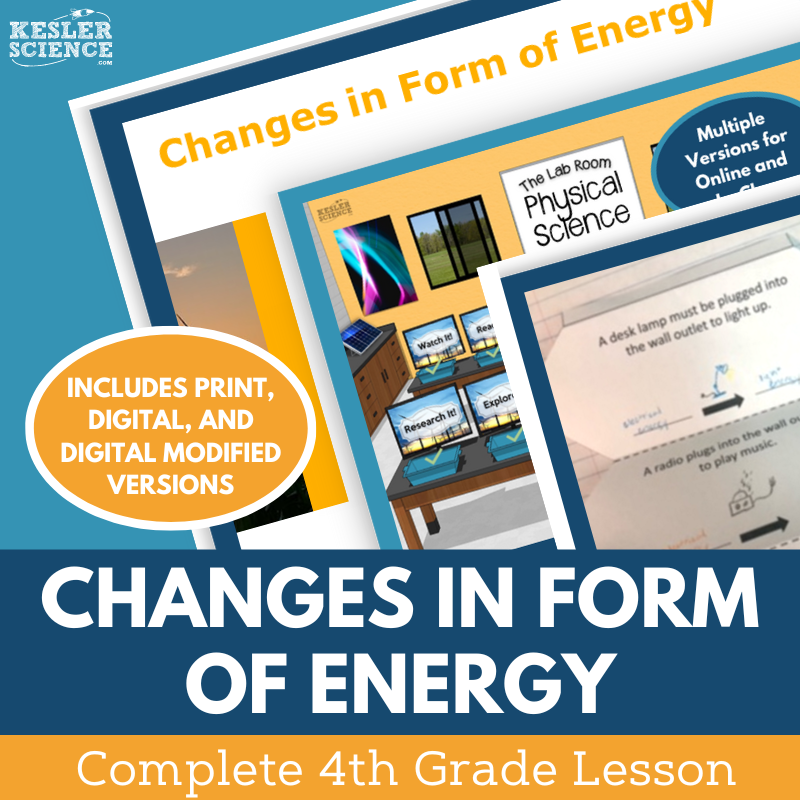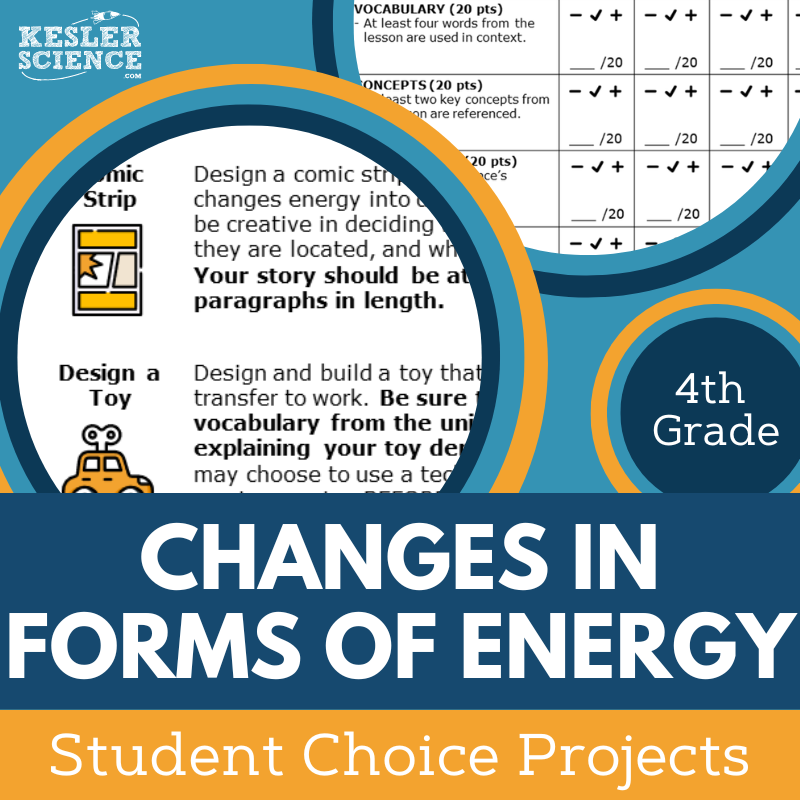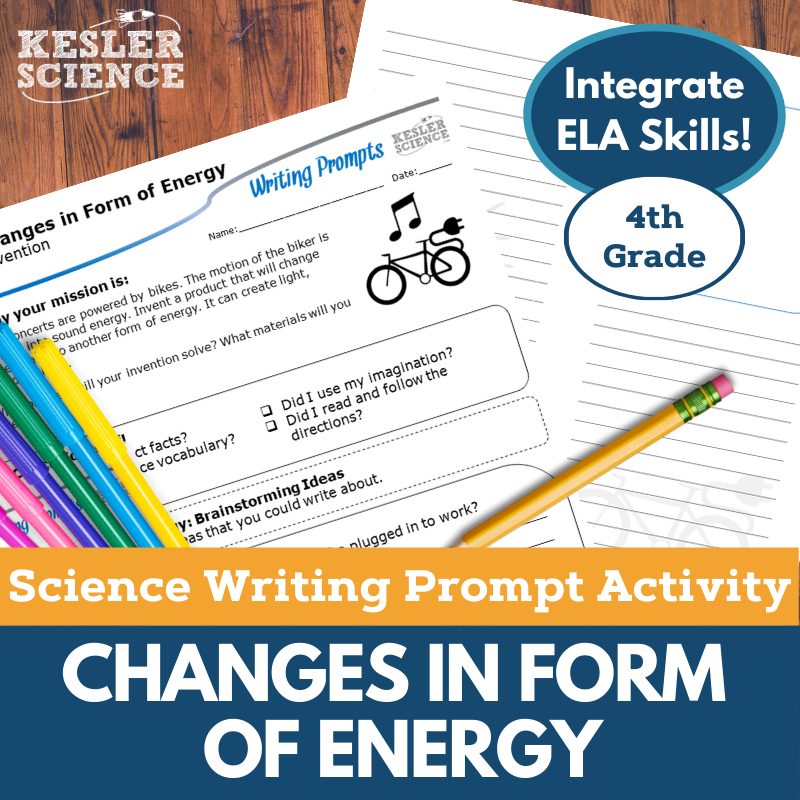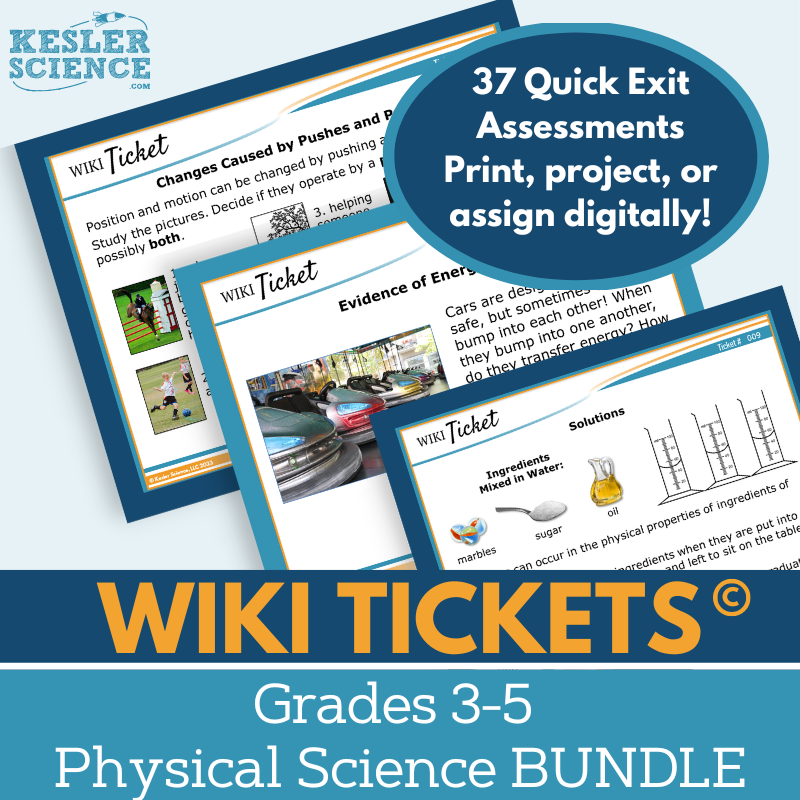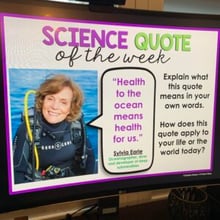Changes in Forms of Energy Activities for 4th Grade Science
Help students explore energy transformations with this engaging 5E lesson designed for student-led learning. The resources below will give students a comprehensive understanding of energy transformations. All of the following materials are also included in the Kesler Science Membership.
The Kesler Science Changes in Form of Energy 5E Lesson is a comprehensive, low-prep physical science unit designed for engaging, student-led learning. It includes editable presentations, worksheets, choice projects, and assessments, all aligned with NGSS 4-PS3-4 and the 2021 TEKS standard for Investigating Energy Transfer.
The lesson follows the 5E Model, offering engaging discussions and activities, a hands-on, differentiated station lab with nine multimodal stations, and editable PowerPoints with interactive notebooks in English and Spanish. Students explore energy conversions through experiments, reading passages, videos, research, and categorization activities. They extend their learning through student-choice projects and demonstrate mastery with assessment questions updated for STAAR 2.0.
Designed for flexibility, the lesson includes printable and digital resources, Spanish translations, and differentiation support. It is fully adaptable for both in-class and virtual learning, ensuring accessibility for all students.
The Kesler Science Changes in Form of Energy 5E Lesson is a comprehensive, low-prep physical science unit designed for engaging, student-led learning. It includes editable presentations, worksheets, choice projects, and assessments, all aligned with NGSS 4-PS3-4 and the 2021 TEKS standard for Investigating Energy Transfer.
The lesson follows the 5E Model, offering engaging discussions and activities, a hands-on, differentiated station lab with nine multimodal stations, and editable PowerPoints with interactive notebooks in English and Spanish. Students explore energy conversions through experiments, reading passages, videos, research, and categorization activities. They extend their learning through student-choice projects and demonstrate mastery with assessment questions updated for STAAR 2.0.
Designed for flexibility, the lesson includes printable and digital resources, Spanish translations, and differentiation support. It is fully adaptable for both in-class and virtual learning, ensuring accessibility for all students.
Engage your 4th-grade students with this interactive, student-led station lab on Changes in Forms of Energy. This lesson allows students to explore energy conversions through hands-on experiments, digital tasks, and multimodal learning experiences. With a student-centered approach, learners actively investigate scientific ideas, applying their knowledge to design and refine devices that transform energy from one form to another.
Through nine engaging stations, students demonstrate their understanding by conducting hands-on experiments, analyzing videos, reading informational passages, answering questions, organizing information, sketching models, and writing explanations. Differentiated reading passages in English and Spanish support diverse learners, while the bonus challenge station extends learning with creative projects. Whether working independently or in small groups, students take ownership of their learning in a meaningful way.
Designed for both in-person and virtual learning, this low-prep, high-engagement resource includes all the necessary signage, literature, task cards, and digital activities for easy implementation. Teachers facilitate rather than direct, encouraging inquiry-based exploration and critical thinking. Perfect for any upper elementary physical science curriculum, this station lab makes learning about energy conversions dynamic and student-driven.
Engage your 4th-grade students with this interactive, student-led station lab on Changes in Forms of Energy. This lesson allows students to explore energy conversions through hands-on experiments, digital tasks, and multimodal learning experiences. With a student-centered approach, learners actively investigate scientific ideas, applying their knowledge to design and refine devices that transform energy from one form to another.
Through nine engaging stations, students demonstrate their understanding by conducting hands-on experiments, analyzing videos, reading informational passages, answering questions, organizing information, sketching models, and writing explanations. Differentiated reading passages in English and Spanish support diverse learners, while the bonus challenge station extends learning with creative projects. Whether working independently or in small groups, students take ownership of their learning in a meaningful way.
Designed for both in-person and virtual learning, this low-prep, high-engagement resource includes all the necessary signage, literature, task cards, and digital activities for easy implementation. Teachers facilitate rather than direct, encouraging inquiry-based exploration and critical thinking. Perfect for any upper elementary physical science curriculum, this station lab makes learning about energy conversions dynamic and student-driven.
The Changes in Forms of Energy Student Choice Projects provide fourth-grade students with various ways to demonstrate their understanding by selecting a project that suits their preferred output style. A project page outlines six student-led options plus a “design your own” project, all supported by an editable rubric for teacher, peer, or self-assessment.
These projects are flexible and allow teachers to modify the rubric to fit their grading needs. Two versions of the project page support differentiation, with modified options for students needing remediation and challenge opportunities for advanced learners.
Students can complete their projects using standard classroom supplies like paper, markers, and scissors, with many options available for digital completion. Some projects may benefit from additional crafting supplies for model-building.
The Changes in Forms of Energy Student Choice Projects provide fourth-grade students with various ways to demonstrate their understanding by selecting a project that suits their preferred output style. A project page outlines six student-led options plus a “design your own” project, all supported by an editable rubric for teacher, peer, or self-assessment.
These projects are flexible and allow teachers to modify the rubric to fit their grading needs. Two versions of the project page support differentiation, with modified options for students needing remediation and challenge opportunities for advanced learners.
Students can complete their projects using standard classroom supplies like paper, markers, and scissors, with many options available for digital completion. Some projects may benefit from additional crafting supplies for model-building.
The Changes in Form of Energy science writing activity engages 4th-grade students in testing their physical science knowledge through an invention design model. This print-or-digital exercise promotes science reasoning, exploration, and writing skills while supporting both in-person and virtual learning.
Aligned with NGSS 4-PS3-4, this creative, low-prep activity helps students apply scientific ideas to design, test, and refine a device that converts energy from one form to another. It includes teacher directions with rubrics and project ideas, a projection version for classroom display or virtual sharing, full-sized and half-sheet handouts with writing prompts and pre-writing strategies, and a digital interactive version in PowerPoint, compatible with Google Slides.
Ideal for cross-curricular learning, pre-test assessments, student choice projects, elaboration for early finishers, extra credit, make-up work, and differentiation, this engaging writing prompt can be displayed on bulletin boards or compiled into student anthologies. Designed for review, it assumes prior knowledge or access to research materials.
The Changes in Form of Energy science writing activity engages 4th-grade students in testing their physical science knowledge through an invention design model. This print-or-digital exercise promotes science reasoning, exploration, and writing skills while supporting both in-person and virtual learning.
Aligned with NGSS 4-PS3-4, this creative, low-prep activity helps students apply scientific ideas to design, test, and refine a device that converts energy from one form to another. It includes teacher directions with rubrics and project ideas, a projection version for classroom display or virtual sharing, full-sized and half-sheet handouts with writing prompts and pre-writing strategies, and a digital interactive version in PowerPoint, compatible with Google Slides.
Ideal for cross-curricular learning, pre-test assessments, student choice projects, elaboration for early finishers, extra credit, make-up work, and differentiation, this engaging writing prompt can be displayed on bulletin boards or compiled into student anthologies. Designed for review, it assumes prior knowledge or access to research materials.
The WIKI Tickets© Physical Science Set provides engaging, flexible formative assessments for 3rd–5th grade science. This set includes 37 exit tickets, each available in five formats: a full-screen projection version, three printable handouts, and an interactive digital version compatible with PowerPoint and Google Slides.
Aligned with NGSS and TEKS standards, these assessments cover key physical science topics, including forces and motion, energy transformations, states of matter, circuits, mixtures, and gravitational force. Each standard has at least one ticket, and some topics feature multiple assessments. A bonus table of contents file is included to show alignment.
WIKI Tickets© can be used in both in-person and virtual learning settings. Students can respond on printed handouts, their own paper, or digitally in a 1:1 or remote environment. These colorful, engaging assessments work as exit tickets, bellringers, or quick checks to gauge student understanding at any time.
The WIKI Tickets© Physical Science Set provides engaging, flexible formative assessments for 3rd–5th grade science. This set includes 37 exit tickets, each available in five formats: a full-screen projection version, three printable handouts, and an interactive digital version compatible with PowerPoint and Google Slides.
Aligned with NGSS and TEKS standards, these assessments cover key physical science topics, including forces and motion, energy transformations, states of matter, circuits, mixtures, and gravitational force. Each standard has at least one ticket, and some topics feature multiple assessments. A bonus table of contents file is included to show alignment.
WIKI Tickets© can be used in both in-person and virtual learning settings. Students can respond on printed handouts, their own paper, or digitally in a 1:1 or remote environment. These colorful, engaging assessments work as exit tickets, bellringers, or quick checks to gauge student understanding at any time.
Year-Round Resources
These year-round activities will increase your students' understanding of many middle school science topics. All of these activities are also included in the Kesler Science Membership.
Visual Data & Graphing
You're not alone if your students struggle with understanding graphs, charts, and tables. It's a skill that takes an enormous amount of practice. This resource will help students build a strong foundation in analyzing data and creating their own data visualizations.
Bell Ringers and Warm-Ups
These middle school science bell ringers are an excellent way to engage your students as soon as they walk into your classroom. This comprehensive FULL YEAR resource includes everything you need to start off each science class with an interesting warm-up activity.
Review Board Games
Each game board has been carefully designed to keep students engaged. There are 10 different action spaces on each board and dozens of question cards. All of the actions are related to science concepts and keep the students motivated throughout the game.
Each game is ready to play. Simply print out the board and the cards and let the students enjoy reviewing nine different units.
Essential Questions and Standards
Below are the essential questions and standards associated with the lessons and activities included in the changes in forms of energy unit. This topic is only one of more than 100 middle school science topics included in the Kesler Science Membership.
-
Give some examples of devices that convert one form of energy to another.
-
How can using a device to convert forms of energy be used to solve a problem?
-
NGSS - 4-PS3-4 Changes in Forms of Energy
Kesler Science Membership
Imagine never having to search for another middle school science lesson again. The membership gives you access to ALL of the Kesler Science products in one place (Yes, including everything above).
Say goodbye to long hours of lesson prep.

